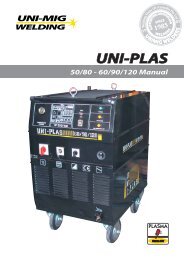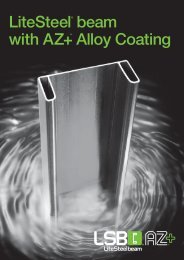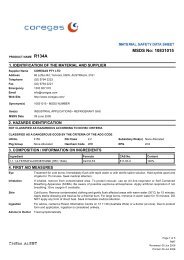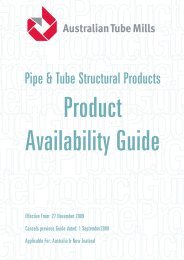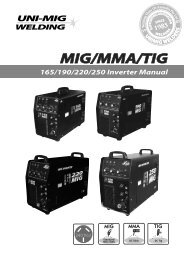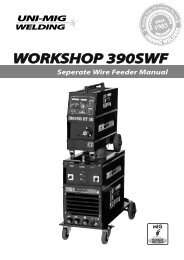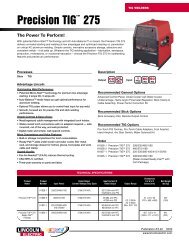Weldmatic 175 [internal wirefeeder] - BJH
Weldmatic 175 [internal wirefeeder] - BJH
Weldmatic 175 [internal wirefeeder] - BJH
You also want an ePaper? Increase the reach of your titles
YUMPU automatically turns print PDFs into web optimized ePapers that Google loves.
<strong>Weldmatic</strong> <strong>175</strong>Burn protectionThe welding arc is intense and visibly bright.Its radiation can damage eyes, penetratelight-weight clothing, reflect from lightcolouredsurfaces, and burn the skin andeyes. Burns resulting from gas-shielded arcsresemble acute sunburn, but can be moresevere and painful.Wear protective clothing - leather or heatresistant gloves, hat, and safety-toe boots.Button shirt collar and pocket flaps, andwear cuffless trousers to avoid entry ofsparks and slag.Avoid oily or greasy clothing. A spark mayignite them. Hot metal such as electrodestubs and work pieces should never behandled without gloves.Ear plugs should be worn when welding inoverhead positions or in a confined space.A hard hat should be worn when others areworking overhead.Flammable hair preparations should not beused by persons intending to weld or cut.Toxic fumesAdequate ventilation with air is essential.Severe discomfort, illness or death canresult from fumes, vapours, heat, or oxygendepletion that welding or cutting mayproduce. NEVER ventilate with oxygen.Lead, cadmium, zinc, mercury, and berylliumbearing and similar materials when weldedor cut may produce harmful concentrationsof toxic fumes. Adequate local exhaustventilation must be used, or each person inthe area as well as the operator must wearan air-supplied respirator. For beryllium, bothmust be used.Metals coated with or containing materialsthat emit fumes should not be heated unlesscoating is removed from the work surface,the area is well ventilated, or the operatorwears an air-supplied respirator.Work in a confined space only while it isbeing ventilated and, if necessary, whilewearing air-supplied respirator.Vapours from chlorinated solvents can bedecomposed by the heat of the arc (orflame) to form phosgene, a highly toxicgas, and lung and eye irritating products.The ultra-violet (radiant) energy of the arccan also decompose trichlorethylene andperchlorethylene vapours to form phosgene.Do not weld or cut where solvent vapourscan be drawn into the welding or cuttingatmosphere or where the radiant energycan penetrate to atmospheres containingeven minute amounts of trichlorethylene orpercholorethylene.Fire and explosion preventionBe aware that flying sparks or falling slag canpass through cracks, along pipes, throughwindows or doors, and through wall or flooropenings, out of sight of the operator. Sparksand slag can travel up to 10 metres from the arc.Keep equipment clean and operable, free ofoil, grease, and (in electrical parts) of metallicparticles that can cause short circuits.If combustibles are present in the workarea, do NOT weld or cut. Move the work ifpracticable, to an area free of combustibles.Avoid paint spray rooms, dip tanks, storageareas, ventilators. If the work can not bemoved, move combustibles at least 10metres away out of reach of sparks and heat;or protect against ignition with suitable andsnug-fitting fire-resistant covers or shields.Walls touching combustibles on oppositesides should not be welded on or cut. Walls,ceilings, and floor near work should beprotected by heat-resistant covers or shields.Model No CP122, Iss A 07/07
<strong>Weldmatic</strong> <strong>175</strong>1 IntroductionGas Metal Arc Welding (G.M.A.W.) is an arcwelding process where a consumable wire isfed by motor driven feed rolls to a weldinggun, and where welding current is suppliedfrom the welding power source. The weldingarc is struck between the work piece andthe end of the wire, which melts into theweld pool. The arc and the weld pool areboth shielded by gas flow from the gun, orin the case of “self shielded” wires, by gasesgenerated by the wire core.2 ReceivingCheck the equipment received against theshipping invoice to make sure the shipmentis complete and undamaged. If any damagehas occurred in transit, please immediatelynotify your supplier.The process is very versatile in that byselection of the correct wire composition,diameter and shielding gas, it can be usedfor applications ranging from sheet-metal toheavy plate, and metals ranging from carbonsteel to aluminium alloys.The <strong>Weldmatic</strong> <strong>175</strong> has been designed tobe used with consumable wires in the rangefrom 0.6mm to 1.2mm diameter. The smallerwire sizes are used when welding at lowercurrents, such as sheet-metal applications.Increasing the wire diameter permits higherwelding currents to be selected.A common application of G.M.A.W. is forwelding Mild Steel. In this application, aMild Steel solid consumable wire such asAUSTMIG ES6 is used with a shielding gasof Carbon Dioxide, or Argon mixed withCarbon Dioxide. Alternatively, Flux-coredconsumable wires are available in both gasshielded, and ‘gasless’ self shielding types.Stainless steel and Aluminium can be weldedwith G.M.A.W. using the correct consumablewire and shielding gas.The <strong>Weldmatic</strong> <strong>175</strong> <strong>wirefeeder</strong> has beendesigned to feed a range of hard, soft, andflux-cored wires for the G.M.A.W. process.A compact motor with integral gear box iscoupled to a two roll drive assembly formingthe basic component of the <strong>wirefeeder</strong>. Themotor is controlled by an electronic speedcontrol which provides speed regulation.Model No CP122, Iss A 07/07
Operators Manual3 SpecificationsManufactured to Australian StandardAS60974.1.Primary Voltage240 Vac, 50/60 HzRated Primary Current12 AmpsMaximum Primary Current28 AmpsRecommended Generator kVA6.7 kVARated Output @ 40 o CDuty cycle based on 10 minute cycle time<strong>175</strong> Amp, 22.8 V, 15% duty67 Amp, 18 V, 100% dutyWelding Current35 - <strong>175</strong> AmpsIf the supply cable is damaged it mustbe replaced by the manufacturer, theirservice agent or a similarly qualifiedperson.CoolingFan cooled, air drawn in through rear grille.InsulationClass H, 140°C RiseSpool Sizes1 kg, 5 kgWirespeed Range0 - 160 RPM (0 - 15 Metres per min.)Wire Size Range0.6mm - 0.9mm diameter (solid wire)0.8mm - 1.2mm diameter (cored wire)Open Circuit Voltage19 - 40 VShipping weight45 kgMains Circuit Breaker Rating16 AmpsSupply plug15 AmpFitted Supply Cable30/0.25 Three Core, Heavy Duty PVCQuality • Reliability • Performance
<strong>Weldmatic</strong> <strong>175</strong>4 Controls12345678Fig 1 Power Source Controls1 Wire Speed ControlThis control provides adjustment of thewirefeed speed. Rotating the dial in aclockwise direction will increase the wirefeedspeed, thereby increasing the weldingcurrent.Refer to the Weld Setting Chart in Section7 of this manual for information on settingthese controls to obtain the intendedwelding current. This chart is also locatedinside the wire-spool enclosure cover2 Euro Gun/Cable Connector.3 Coarse Voltage ControlThis switch provides Coarse adjustmentof the output welding voltage over threeranges.4 Over Temprature IndicatorLights up if the unit over heats5 Fine Voltage ControlThis switch provides Fine adjustment of theoutput welding voltage over three ranges.Note: Minimum welding voltage is obtainedwith Coarse A and Fine 1 selected. Maximumwelding voltage is obtained with Coarse Cand Fine 3 selected.Do not operate the Voltage Controlswitches during welding6 Standby/Operate Switch7 Positive Welding Output Terminal8 Negative Welding Output TerminalModel No CP122, Iss A 07/07
Operators Manual5 InstallationConnection to Electrical Mains PowerSupplyThe <strong>Weldmatic</strong> <strong>175</strong> is factory fitted with a3 metre, 3 core 30/0.25 Heavy Duty PVCmains power supply cable with moulded 3pin, 15 Amp, Single Phase plug.A 15 Amp plug and socket is recognisable bya wide Earth pin. Power Supply authoritiesrequire that equipment fitted with a 15 Ampplug shall ONLY be connected to a 240 Volt,15 Amp power point. DO NOT modify theplug.The minimum capacity of the mains wiringand power outlet supplying a welder isselected according to the effective primarycurrent of the equipment. The effectiveprimary current for the <strong>Weldmatic</strong> <strong>175</strong> is12 Amps.The minimum recommended mains circuitbreaker rating for a <strong>Weldmatic</strong> <strong>175</strong> is16 Amps. Note : Due to normal variationsof sensitivity, the tripping time of some 16Acircuit breakers may limit the duty cycleavailable from the <strong>Weldmatic</strong> <strong>175</strong>. A higherrated circuit breaker can be selected, but themains wiring capacity must be rated to suit.The current rating of the mains cabledepends on cable size and method ofinstallation. Refer to AS/NZS 3008.1, Table 9.If it becomes necessary to replace the mainsflexible supply cable, use only cable withcorrect current rating. Access to the supplyterminals is gained by removing the powersource side panels.The replacement cable must be fitted andretained in the same manner as the original.Output Voltage PolarityThe design of the <strong>Weldmatic</strong> <strong>175</strong> allowsselection of the output voltage polarity.Positive WireG.M.A.W. with solid consumable wires iscarried out with the work piece Negative andthe welding wire Positive.To setup for this condition, connect the‘WORK’ lead plug into the (-) output socketon the Power Source, and the ‘WELDING’lead from the power source into the (+)socket, as in Figure 2.Negative WireFig 2 Positive WireFig 3 Negative WireTo gun cableTo work clampSome ‘self-shielded’ flux cored consumablewires are operated with the work piecePositive and the consumable wire Negative.Refer to the manufacturers data for theparticular consumable wire to be used.To setup for this condition, connect the‘WORK’ lead plug into the (+) output socketon the Power Source, and the ‘WELDING’lead from the power source into the (-)socket, as in Figure 3.To work clampTo gun cableQuality • Reliability • Performance
<strong>Weldmatic</strong> <strong>175</strong>Fitting the gas cylinderPlace the gas cylinder on the tray at therear of the optional welder trolley (if using).Retain the cylinder with the chain provided.Fit the gas regulator to the cylinder. DO NOTapply grease or oil to these joints.Fit the end of the gas inlet hose from theback of the power source to the connectorsupplied with the gas regulator, and securewith the clamp also supplied.Fitting The Gun and Cable AssemblyThe supplied gun/cable assembly is equippedwith a ‘Euro’ <strong>wirefeeder</strong> connector whichincorporates all required connection pointsfor welding current, shielding gas and gunswitch control.To attach the gun/cable assembly tothe <strong>wirefeeder</strong> mechanism, engage themating parts of the male and female Euroconnectors, then rotate the locking ringclockwise to firmly secure the connection.Fitting the Consumable WireThe quality of the consumable wiregreatly affects how reliably a gasmetal arc welder will operate. For bestresults when welding mild steel, werecommend quality WIA AUSTMIG ES6.Dirty, rusty or kinked wire will not feedsmoothly through the gun cable andwill cause erratic welding. Deposits fromthe wire will clog the gun cable linerrequiring it to be replaced prematurely.5 kg SpoolsPlace the spool of welding wire onto thespool holder. The location pin should matewith a hole provided on the wire spool body.Fit the spool retaining ‘R’ clip supplied. Checkthe adjustment of the spool adjuster, whichshould be set to prevent over run of the wirespool at the end of a weld, without undulyloading the wirefeed motor.1 kg SpoolsRemove the adjustor knob, spring, washerand 5 kg spool holder. Leave the 5 kg spoolholder in a safe place (ie inside the welder).Fit the 1kg wire spool directly onto the spoolaxle. Fit the washer, spring and adjustor knoband tighten the adjustor knob fully.Feeding the Consumable WireAt the wirefeed assembly, release thecompression screw by swivelling it outwards.This allows the top roller arm to spring to theopen position. The end of the welding wirecan now be passed through the inlet guide,over the bottom driven roller, and into theoutput wire guide tube. Check that the driveroll groove is correct for the wire in use. Theappropriate size is stamped on the visibleside of the installed roller. Check also thatthe correct size contact tip is fitted at the gunend. Feed roller and tip details are shown inSection 11 of this manual.Return the top roller arm to the closedposition and adjust the compression screw toprovide sufficient clamping of the drive rollto achieve constant wirefeed. Do not overtighten.With the equipment energised, operate thegun switch to feed wire through the guncable.Compression screwTop roller armGroove sizeModel No CP122, Iss A 07/07
Operators Manual6 Normal Welding SequenceWeld StartClosing the welding gun switch initiates thissequence of events:• The gas valve is energised and gas flowcommences;• The power source contactor is initiated.Welding voltage is applied between thework piece and the consumable wire.• The wire drive motor is energised.• The wire touches the work piece, and thearc is established.Weld EndReleasing the gun switch initiates thissequence of events:• The wire drive motor is de-energised, andis dynamically braked to a stop;• The welding transformor is de-energisedand welding current stops.• The gas valve is de-energised and theflow of shielding gas ceases.7 Basic Welding InformationChoice of Shielding GasThe choice of shielding gas is largelydetermined by the consumable wire tobe used. Many proprietary shielding gasmixtures are available.The recommended shielding gases for usewith the <strong>Weldmatic</strong> <strong>175</strong> are:• Mild Steel Argon +5 to 25% CarbonDioxide;• Aluminium Argon;• Stainless Steel Argon + 1 to 2%Oxygen.Consult your gas supplier if more specificinformation is required.Shielding Gas Flow RateIn G.M.A. welding, one function of theshielding gas is to protect the molten weldpool from the effects of oxygen in theatmosphere. Without this protection theweld deposit becomes ‘honeycombed’ inappearance, an effect which is described asweld porosity.In draft-free conditions the gas flow raterequired to give adequate protection istypically 10-12 litres/min. In situations wheredrafts cannot be avoided, it may be necessaryto increase this rate up to 20 litres/min, and/or to provide screening of the work area.Weld porosity can also be caused by airentering the gas stream through a damagedhose, loose gas connection, or fromrestriction in the nozzle, such as from excessbuild-up of spatter.When welding aluminium, particular caremust be taken with all aspects of shieldinggas delivery and workpiece preparation inorder to avoid weld porosity.10Quality • Reliability • Performance
<strong>Weldmatic</strong> <strong>175</strong><strong>Weldmatic</strong> <strong>175</strong>Settings ChartFig 4 Weld Setting ChartsModel No CP122, Iss A 07/07 11
Operators Manual<strong>Weldmatic</strong> <strong>175</strong>Settings Chart (cont)Fig 4 Weld Setting Charts12Quality • Reliability • Performance
<strong>Weldmatic</strong> <strong>175</strong>Establishing a Weld SettingOnce the consumable wire type, wire sizeand shielding gas have been chosen, the twovariables that are adjusted in order to obtaina the desired weld setting are;• Wirefeed speed,• Welding arc voltage.The Weld Setting Charts in Figure 4 can beused to preset the machine for an approximatewelding current. For each of the combinationsof voltage control switch settings, there is arange of valid wirespeed settings.The wirefeed speed determines the weldingcurrent; increasing the speed increases thecurrent, and decreasing it decreases current.The selected wirefeed speed must bematched with sufficient arc voltage; a speedincrease requires an increase of arc voltage.If the voltage is too low the wire will stuband stutter, and there will not be a steadyarc. If the voltage is too high the arc will belong with metal transfer occurring as a seriesof large droplets.Important: Do not operate the VoltageControl switches during welding.The weld setting should be chosen to suit theapplication and the thickness of the metal tobe welded. It is important to check that thedeposited weld provides sufficient strengthto suit the application.A “good” weld will have the characteristicsillustrated in Figure 5. The weld has penetratedinto the parent metal, fusing the root of thejoint where the two plates meet, and the weldblends smoothly into the side walls.A “bad” weld is shown in Figure 6. The weldhas not penetrated the joint root, and thereis poor side wall fusion. This lack of fusionwould normally be corrected by increasingthe arc voltage, or by increasing bothwirefeed speed and arc voltage to achieve ahigher current weld setting.Gun PositionFig 5 “Good” WeldFig 6 “Bad” WeldFor “down hand” fillet welding with gasshielded solid wires, the gun is normallypositioned as shown in Figure 7a below, withthe nozzle end pointing in the direction oftravel.For “down hand” fillet welding withgasless flux cored wires, the gun is normallypositioned as shown in Figure 7b below,with the nozzle end pointing away from thedirection of travel, referred to as ‘dragging’the weld. Gasless flux cored wires should beModel No CP122, Iss A 07/07 13
Operators Manualoperated with approximately 15mm of wire‘stick-out’ from the welding contact tip asshown in Figure 7c.Fig 7a Gas Shielded Solid WiresDuty CycleThe term duty cycle indicates the percentagewelding time available at the rated outputcurrent, for each 10 min period over 4 hours.The <strong>Weldmatic</strong> <strong>175</strong> is rated <strong>175</strong> Amps, 15%duty cycle. If the machine is operated at areduced welding current, a higher duty cycleis available. The diagram below illustrates theappropriate duty cycle rating for the range ofwelding currents available from the <strong>175</strong>, andso allows the maximum welding time per 10minute period to be determined.The power source is protected by in builtover temperature protection devices. Thesewill operate if the machine is operated inexcess of its current and duty cycle rating. Ifthis occurs, the fan will continue to run, butthe machine will not deliver welding currentuntil the unit has cooled sufficiently.Fig 7b Gasless Flux Cored WiresFig 8 Duty Cycle RatingFig 7c Wire Stickout for Gasless Welding14Quality • Reliability • Performance
<strong>Weldmatic</strong> <strong>175</strong>8 General MaintenanceBefore removing the equipmentcover, ENSURE that the equipmentis disconnected from the mainspower supply. When the equipmentis energised LETHAL VOLTAGES arepresent on the electrical componentsenclosed.DustCare should be taken to prevent excessivebuild-up of dust and dirt within the weldingpower source. It is recommended that atregular intervals, according to the prevailingconditions, the equipment covers be removedand any accumulated dust be removed by theuse of dry, low pressure compressed air, or avacuum cleaner.WirefeedIn order to obtain the most satisfactorywelding results from the G.M.A.W. process,the wirefeed must be smooth and constant.Most causes of erratic wirefeed can be curedby basic maintenance. Check that the:1 Feed rolls are the correct size and type forthe wire in use. Check also that the drivegroove is aligned with the wire (referpage 9), and that the groove is not worn;2 Gun cable liner is clear of dust and swarfbuild-up. When replacement becomesnecessary, fit only the correct liner (seepage 24). The build-up of dust can beminimised by regular purging of the linerwith dry compressed air. This may beconveniently done each time the wirespool is replaced;3 Welding tip is free of obstructions suchas spatter build-up. Ream out the tipbore with a suitable size oxy-tip cleaner.Replace the welding tip as it becomesworn;4 Feed roll pressure is not excessive. Thepressure should be just sufficient to feedthe wire evenly. Excessive pressure willdeform the electrode wire and makefeeding more difficult;5 Consumable wire spool holder rotatessmoothly and that the braking action isnot excessive. The spool should only havesufficient braking to prevent over runwhen the motor stops. This also may beconveniently checked each time the wireis replenished;7 Welding wire is straight and free ofbuckles or ‘waviness’. To check, remove2 or 3 metres of wire from the spool.Clamp one end in a vice or similar, thenholding the other end pull the wire outstraight. Look down the length of thewire, any buckles will be obvious. Buckledwire is extremely difficult to feed reliablyand should be replaced;8 Welding wire is free of surface rust.Replace if rust is evident.Model No CP122, Iss A 07/07 15
Operators Manual9 External Trouble ShootingIf the following checks do not identifythe fault condition, the equipmentshould be returned to a WIA Serviceagent. Phone 1300 300 884 for detailsof your nearest service agent.9 External Trouble ShootingPower source has no output and nowirefeed when gun switch is closed :‘OPERATE’ switch is not illuminated1 Check equipment is connected to afunctional mains power outlet. Test outletusing a known working appliance.‘OPERATE’ switch is illuminated1 The gun switch circuit may be incomplete.• Check the gun switch for continuitywith an ohm meter when the switchis pressed. Replace if faulty• Check the 2 pin receptacles in Euroadaptor are making contact with themating pins from the gun Euro end.2 Power source may have overheated.• The <strong>Weldmatic</strong> <strong>175</strong> welding powersource incorporates an in-builtover-temperature thermostatwhich will trip if the welding loadexceeds the operating duty cycle.The ‘OVERLOAD’ light will beilluminatedwhen the gun is switchedon. The thermostat will resetautomatically - do not switch theequipment off as the cooling fan willassist the resetting of the thermostat• If problem persists after the cool downperiod, call your WIA service agent.Power source has low weld output1 Check all electrical connections in thewelding current circuit, including weldcable, work clamp and gun/cable assembly.Circuit breaker trips during welding1 Check the rating of the mains supplycircuit breaker. The <strong>Weldmatic</strong> <strong>175</strong>should be supplied from a 16 Amp orlarger circuit breaker.Unsatisfactory Welding Performanceand ResultsErratic arc characteristics caused by poorwirefeedErratic wirefeed is the MOST LIKELY cause offailure in all Gas Metal Arc Welding. It shouldtherefore be the first point checked whenproblems occur.1 Refer to the points in ‘Wirefeed’ inSection 82 Check if the consumable wire is slippingin the drive rolls. Replace the feed roll ifit is the incorrect size or is worn3 Check that gun cable liner is not tooshort and is fitted correctly. Refer topage 24 for fitting instructions.Constant poor arc characteristicsCheck that the:1 Correct polarity has been selected forwork and weld cables (refer page 8)2 Shielding gas is correct for theconsumable wire in use (refer page 10)3 Welding circuit is making good electricalconnection. Ensure that the work clampis securely tightened onto the work pieceso that good electrical contact is achieved16Quality • Reliability • Performance
<strong>Weldmatic</strong> <strong>175</strong>4 All connections in the external weldingcircuit are clean and tight. Problems mayshow as hot spots5 Work piece surface is not contaminated.Water, oil, grease, galvanising, paint,or oxide layers can severely disturb thewelding arc and result in a poor weld.Porosity in weld caused by lack ofshielding gas1 Check that the correct gas flow rate hasbeen set (refer page 10)2 Check for leaks in the gas hose. Replaceif leaking3 Check for leaks in gun/cable assembly,eg. fractured gas hose, broken or missing‘O’ rings. Replace as required4 Check the gun nozzle is free from spatterand is firmly attached to the welding gunto ensure that no air is being drawn intothe shielded area.Model No CP122, Iss A 07/07 17
Operators Manual10 Service InformationThe following information is intendedfor use by qualified service personnel.When the unit is energised LETHALVOLTAGES are present on the electricaland electronic components. It is notintended that persons without suitabletraining and knowledge attemptto perform service tasks on thecomponents of this welder.Before removing the equipmentcover, ENSURE that the equipmentis disconnected from the mainspower supply. When the equipmentis energised LETHAL VOLTAGES arepresent on the electrical componentsenclosed.10.1 PWA006 Control BoardFig 9 PWA006 Control Board18Quality • Reliability • Performance
<strong>Weldmatic</strong> <strong>175</strong>10.2 Circuit DiagramFig 10 <strong>Weldmatic</strong> <strong>175</strong> Circuit DiagramModel No CP122, Iss A 07/07 19
Operators Manual11.1 Assembly and Parts List - <strong>Weldmatic</strong> <strong>175</strong> Power Source67548932110111213141716152019182122232824252726Fig 11 <strong>Weldmatic</strong> <strong>175</strong> Power Source Assembly20Quality • Reliability • Performance
<strong>Weldmatic</strong> <strong>175</strong>Item # Part # Description Qty1 W29-1/20 Slam Action Catch 12 PAN072 Side Door 13 WF001-6 Euro Surround, Plastic 14 W41-0/1 Hinge Set Left Hand 15 W41-0/2 Hinge Set Right Hand 16 MZ208015 Handle Assembly 27 PAN073 Side/Top Cover 18 CP110-10/1N Rotary Switch (including knob and dust cover) 29 LST022 Label Set Complete 110 SA140-0/2 Socket, Dinse 211 WGEC3 Plug, Dinse 212 CABW10 Welding Cable 10mm 2 113 M0029 Adjusting Knob, Large 114 E0042 On/Off Switch 115 AM321 1/5 kg Spool Holder Assembly 116 AM133-3 Rclip (included in AM321) 117 WF023 Wirefeed Assembly 118 SUB021 Snubber 119 PWA006N Wirefeed Control PCB Assembly 120 CP104-0/2 Rectifier 1CP3-9/8 Thermostat (included in rectifier) 121 62513 Blue Oxy Single Gas Hose, 5 metre 122 E0041 Gas valve 24 vdc 123 E0044 Relay 124 FAN006 Fan Assembly 125 CP101-0/17 Fan Finger Guard 126 HF200-1/15 Plastic Foot 427 TFM042N Welding Transformer/Inductance Assembly, Wired 1CP104-16/2 Thermostat (included in transformer) 128 WGWC1 Work Clamp 1Not shown REG001 Argon Regulator 1Not shown GUN001 200A Gun/Cable Assembly, 3 metre, Euro Connect 1Not shown CP122-40 Operating Manual 1Model No CP122, Iss A 07/07 21
Operators Manual11.2 Assembly and Parts List - Wirefeeder21Fig 12 Wirefeed AssemblyItem # Part # Description Qty1 W27-0/9 Retaining Screw 1Feed RollsItem # Part # Description2 W26-0/8 0.6 + 0.8mm, Solid Wire2 W26-8/8 0.8 + 0.9mm, Solid Wire2 W26-7/8 1.0//1.2mm, Flux Cored Wire (knurled)2 W26-9/8 0.9//1.2mm, Flux Cored Wire (knurled)2 W25-3/8 1.0/1.2mm, Aluminium22Quality • Reliability • Performance
<strong>Weldmatic</strong> <strong>175</strong>11.3 Assembly and Parts List - Gun and Cable Assembly5134267Fig 13 GUN001 (200 amp) Gun and Cable AssemblyItem # Part # Description1 BE4392 Nozzle, Brass, Tapered2 see ‘Tips’ page 24 Contact Tip3 BE4335 Gas Diffuser (Head)4 BE4323 Cap5 BEQT2-45BEQT2-30Body Tube, 2”, 45 o (supplied)Body Tube, 2”, 30 o6 GUN002 Handle Kit (includes both halves, screws & trigger)7 BE43115BE43115XSteel Liner 0.9 - 1.2mmNylon Liner 0.9 - 1.2mmModel No CP122, Iss A 07/07 23
Operators ManualTipsWire diameter0.6mm0.8mm0.9mm1.0mm1.2mmShort series (25mm)BE7497BE7488BE7489BE7496BE7490To replace liner: Disconnect gun/cableassembly at the Euro adaptor. Removenozzle (1) and head (3). Withdraw oldliner from the <strong>wirefeeder</strong> end. Insert newliner and refit gun/cable assembly to the<strong>wirefeeder</strong>.At the gun end, compress the liner withinthe gun cable, then cut it one contact tiplength past the end of the body tube (5).Refit head, tip and nozzle.Cut HereCompress LinerFig 6 Replacing the gun cable liner24Quality • Reliability • Performance
<strong>Weldmatic</strong> <strong>175</strong>12 Warranty InformationWIA Gold Shield 3 Year WarrantyEffective 1st March 2005At WIA, we are serious about productquality.Every new <strong>Weldmatic</strong> and Weldarcmachine comes fully backed by the WIA‘Gold Shield 3 Year Warranty’, coveringparts and workmanship, so you can beguaranteed you’re buying reliability andperformance.This limited warranty supersedes all previousWIA (Welding Industries of Australia)warranties and is exclusive with no otherguarantees or warranties expressed orimplied.Limited WarrantySubject to the terms and conditions below, WIAwarrants to its original retail purchaser that newWIA equipment sold after the effective date ofthis limited warranty is free of defects in materialand workmanship at the time it is shipped byWIA.THIS WARRANTY IS EXPRESSLY IN LIEU OFALL OTHER WARRANTIES, EXPRESS ORIMPLIED, INCLUDING THE WARRANTIES OFMERCHANTABILITY AND FITNESS.Within the warranty periods listed below,WIA will repair or replace any warrantedparts or components that fail due to suchdefects in material or workmanship. WIAmust be notified in writing within thirty (30)days of such defect or failure, at which timeWIA will provide instructions on the warrantyclaim procedures to be followed.WIA shall honour warranty claims onwarranted equipment in the event of such afailure within the warranty time periods. Allwarranty time periods start on the date thatthe equipment was delivered to the originalretail purchaser, or 18 months after theequipment date of manufacture, whicheveris the earlier.Parts and workmanship on Weldarcand <strong>Weldmatic</strong> equipment are coveredfor a period of 3 years (except for gasregulator, gun cable and consumableslisted below.)Items replaced under original warranty arewarranted for the remainder of the originalequipment warranty, or for a period of ninety(90) days, whichever is the greater.Gas regulator and gun/cable assembly arewarranted for 90 days.WIA’s Limited Warranty shall not apply to:1 Consumable components; such ascontact tips, cutting nozzles, contactors,brushes, relays or parts that fail due tonormal wear.2 Equipment that has been modified by anyparty other than WIA, or equipment thathas been improperly installed, improperlyoperated or misused based uponindustry standards, or equipment whichhas not had reasonable and necessarymaintenance, or equipment which hasbeen used for operation outside of thespecifications for the equipment.WIA PRODUCTS ARE INTENDED FORPURCHASE AND USE BY COMMERCIAL /INDUSTRIAL USERS AND PERSONS TRAINEDAND EXPERIENCED IN THE USE ANDMAINTENANCE OF WELDING EQUIPMENT.In the event of a warranty claim coveredby this warranty, the exclusive remediesshall be, at WIA’s option: (1) repair; orModel No CP122, Iss A 07/07 25
Operators Manual(2) replacement; or, where authorised inwriting by WIA in appropriate cases, (3) thereasonable cost of repair or replacementby an authorised WIA service agent; or (4)payment of or credit for the purchase price(less reasonable depreciation based uponactual use) upon return of the goods atcustomer’s risk and expense.WIA’s option of repair or replacement will beF. O. B. Factory at Melrose Park, Adelaide,or F. O. B. at a WIA authorised servicefacility as determined by WIA. Thereforeno compensation or reimbursement fortransportation costs of any kind will beallowed.TO THE EXTENT PERMITTED BY LAW, THEREMEDIES PROVIDED HEREIN ARE THE SOLEAND EXCLUSIVE REMEDIES. IN NO EVENTSHALL WIA BE LIABLE FOR DIRECT, INDIRECT,SPECIAL, INCIDENTAL OR CONSEQUENTIALDAMAGES (INCLUDING LOSS OF PROFIT),WHETHER BASED ON CONTRACT, TORT ORANY OTHER LEGAL THEORY.ANY EXPRESS WARRANTY NOT PROVIDEDHEREIN AND ANY IMPLIED WARRANTY,GUARANTEE OR REPRESENTATION AS TOPERFORMANCE, AND ANY REMEDY FORBREACH OF CONTRACT TORT OR ANYOTHERLEGAL THEORY WHICH, BUT FOR THISPROVISION, MIGHT ARISE BY IMPLICATION,OPERATION OF LAW, CUSTOM OF TRADEOR COURSE OF DEALING, INCLUDING ANYIMPLIED WARRANTY OF MERCHANTABILITYOR FITNESS FOR PARTICULAR PURPOSE,WITH RESPECT TO ANY AND ALLEQUIPMENT FURNISHED BY WIA ISEXCLUDED AND DISCLAIMED BY WIA.26Quality • Reliability • Performance


![Weldmatic 175 [internal wirefeeder] - BJH](https://img.yumpu.com/48683580/1/500x640/weldmatic-175-internal-wirefeeder-bjh.jpg)


